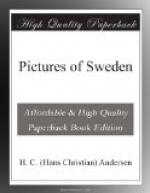We were told that a few days before, five or six schoolboys had unobserved stolen in here, and amused themselves by going from step to step on these machine-like rocking stairs, in pitchy darkness, but at last they knew not rightly which way to go, up or down, and had then begun to shout and scream lustily. They escaped luckily that bout.
By one of the large openings, called “Fat Mads,” there are rich copper mines, but which have not yet been worked. A building stands above it: it was at the bottom of this that they found, in the year 1719, the corpse of a young miner. It appeared as if he had fallen down that very day, so unchanged did the body seem—but no one knew him. An old woman then stepped forward and burst into tears: the deceased was her bridegroom, who had disappeared forty nine years ago. She stood there old and wrinkled; he was young as when they had met for the last time nearly half a century before.[T]
[Footnote T: In another mine they found, in the year 1635, a corpse perfectly fresh, and almost with the appearance of one asleep; but his clothes, and the ancient copper coins found on him, bore witness that it was two hundred years since he had perished there.]
We went to “The Plant House,” as it is called, where the vitriolated liquid is crystallized to sulphate of copper. It grew up long sticks placed upright in the boiling water, resembling long pieces of grass-green sugar. The steam was pungent, and the air in here penetrated our tongues—it was just as if one had a corroded spoon in one’s mouth. It was really a luxury to come out again, even into the rarefied copper smoke, under the open sky.
Steaming, burnt-out, and herbless as the district is on this side of the town, it is just as refreshing, green, and fertile on the opposite side of Fahlun. Tall leafy trees grow close to the farthest houses. One is directly in the fresh pine and birch forests, thence to the lake and to the distant blueish mountain sides near Zaether.
The people here can tell you and show you memorials of Engelbrekt and his Dalecarlians’ deeds, and of Gustavus Vasa’s adventurous wanderings. But we will remain here in this smoke-enveloped town, with the silent street’s dark houses. It was almost midnight when we went out and came to the market-place. There was a wedding in one of the houses, and a great crowd of persons stood outside, the women nearest the house, the men a little further back. According to an old Swedish custom, they called for the bride and bridegroom to come forward, and they did so—they durst not do otherwise. Peasant girls, with candles in their hands, stood on each side; it was a perfect tableau: the bride with downcast eyes, the bridegroom smiling, and the young bridesmaids each with a laughing face. And the people shouted: “Now turn yourselves a little! now the back! now the face! the bridegroom quite round, the bride a little nearer!” And the bridal pair turned and turned—nor was




